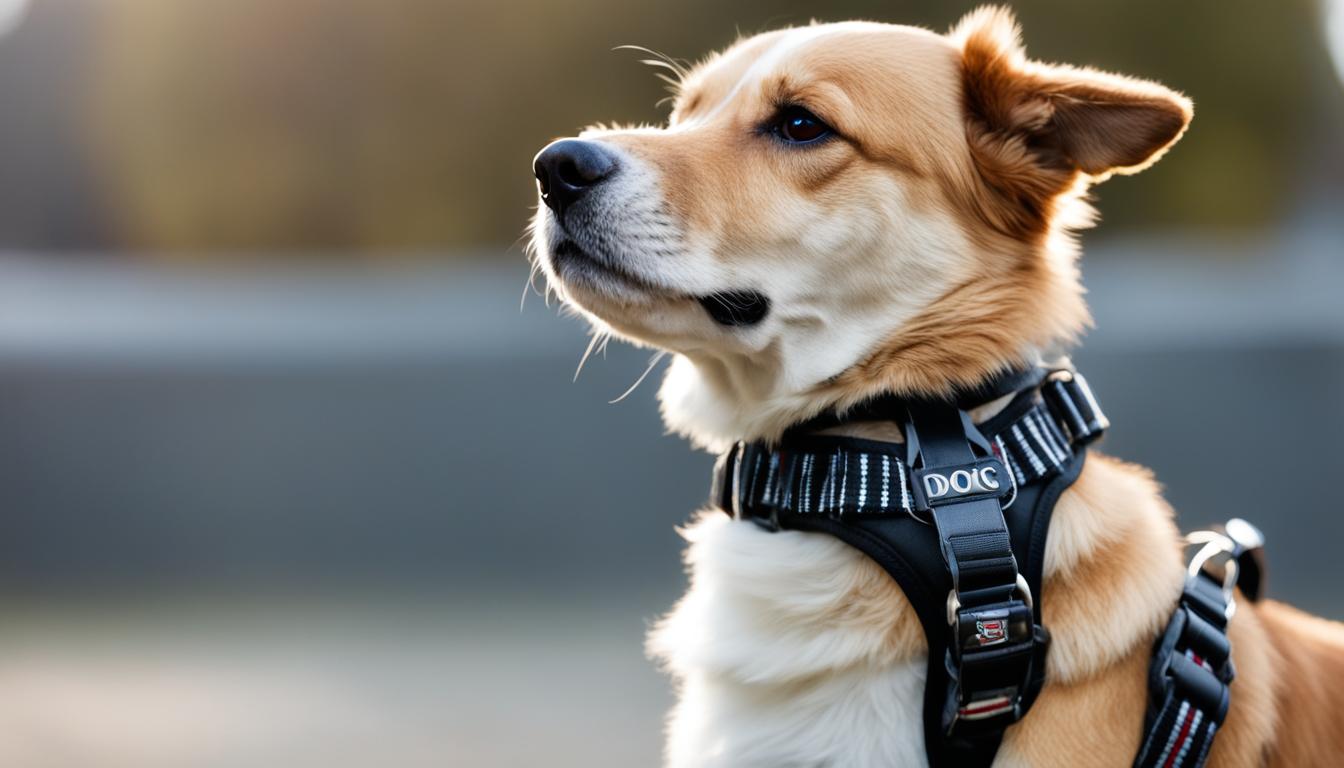Are you tired of your dog pulling you on walks? Training your dog to walk calmly on a leash can be challenging, but with the right tools and techniques, it is possible. One such tool is a no pull dog harness, which can make a world of difference in your dog's behavior and your walking experience. So let's dive into how to use no pull dog harness.
Using a no pull dog harness has numerous benefits. Not only does it prevent your dog from pulling and dragging you around, but it also provides comfort and versatility. By properly fitting the harness and using the right techniques, you can teach your dog to walk on a leash without the struggle of pulling.
Key Takeaways: How To Use No Pull Dog Harness
- The no pull dog harness is a valuable tool for training your dog to walk on a leash without pulling.
- Choosing the right harness size and design is crucial for comfort and effectiveness.
- Properly fitting the harness involves adjusting the straps to snugly fit the dog's body.
- Using the front attachment point on the harness helps redirect the dog's attention and discourages pulling.
- Consistency, patience, and positive reinforcement are key to successful leash training with a no-pull harness.
As an Amazon Associate, we earn from qualifying purchases
Choosing the Right No Pull Dog Harness
When it comes to choosing a no pull dog harness, finding the right fit and design is crucial for effective training. A well-fitting harness can make a significant difference in your dog's behavior and overall walking experience. Here are some key factors to consider:
Sizing Matters
Proper harness sizing is essential for your dog's comfort and safety. Measure your dog's chest girth accurately to ensure the harness fits snugly but doesn't restrict movement. Check the manufacturer's sizing guidelines and choose the size that aligns with your dog's measurements.
Front Attachment Point
Look for a harness with a front attachment point. This design discourages pulling by redirecting your dog's forward momentum. When the leash is attached to the front, pulling causes the harness to tighten around the chest, gently guiding your dog back towards you.
Tip: A harness with both a front and back attachment point provides added versatility, allowing you to switch between control options based on your dog's behavior and training progress.
Quality and Durability
Choose a harness made from durable materials that can withstand your dog's pulling force. Look for reinforced stitching, sturdy hardware, and adjustable straps. A well-made harness will ensure longevity and reliability during your training sessions.
Consider Your Dog's Behavior
Each dog has unique behavior traits and tendencies. Consider your dog's personality, breed, and any specific behavior issues you're addressing. Different harness designs may be more suitable for certain behaviors, so consulting with a professional trainer can provide valuable insights.
Try Before You Buy
If possible, bring your dog along to try on different harnesses. This allows you to see how comfortable they are and assess the fit and ease of use in real time. While trying on harnesses, observe your dog's movement and behavior to ensure they are at ease and not restricted in any way.
Remember, choosing the right no-pull dog harness is essential for successful dog training and behavior modification. By considering factors such as sizing, design, and your dog's behavior, you can find the perfect harness to make your walks enjoyable and stress-free for both you and your furry friend.
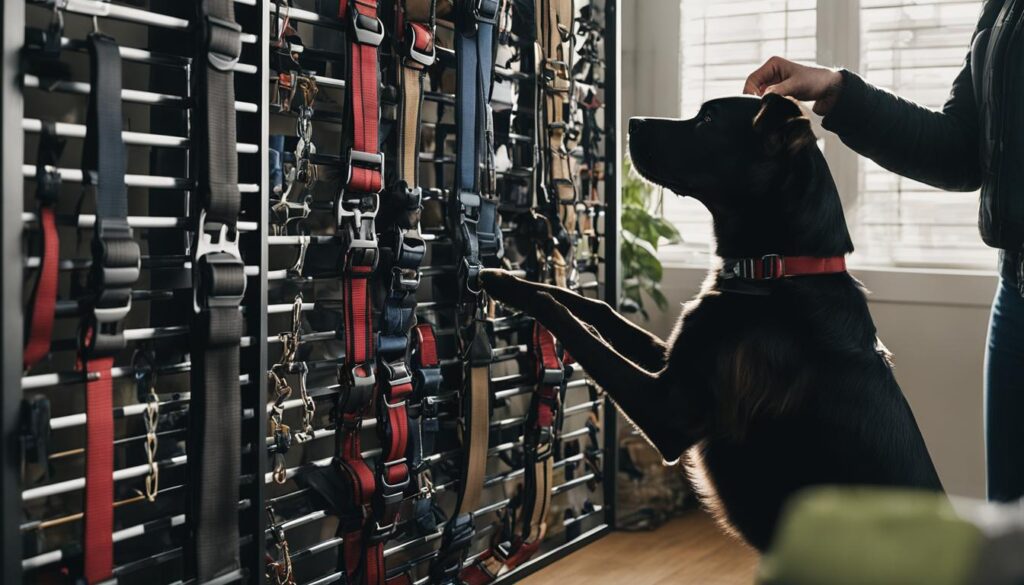

| No Pull Dog Harness Comparison | Front Attachment Point | Back Attachment Point | Size Options | Durability |
|---|---|---|---|---|
| Rabbitgoo Dog Harness No Pull | ✔️ | ✔️ | S/M/L/XL | 🌟🌟🌟🌟 |
| PetSafe® Gentle Leader® Headcollar | ✔️ | ❌ | XS/S/M/L | 🌟🌟🌟 |
| BARKBAY Dog Harness No Pull | ✔️ | ✔️ | M/L/XL | 🌟🌟🌟🌟🌟 |
Step-by-Step Guide to Using a No Pull Dog Harness
Properly fitting a no pull dog harness is essential for effective training. Follow these simple steps to ensure your dog's comfort and convenience:
- Step 1: Unbuckle and place the harness over your dog's head.
Start by unbuckling the harness and carefully slipping it over your dog's head. Ensure that the contrasting loop is positioned on top.
- Step 2: Fasten the harness securely.
Bring the velvet strap up between your dog's front legs and snap the buckles closed on both sides. Make sure the harness fits snugly but comfortably around your dog's chest.
- Step 3: Adjust the harness for a perfect fit.
Once the harness is fastened, adjust it for optimum comfort and functionality. Check that it sits securely around the chest, the front of the chest, and between the front legs. The straps should be snug but not too tight, allowing your dog to move freely.
When choosing a no pull dog harness, look for features that enhance the walking experience. Opt for a harness made of durable materials, such as nylon or polyester, to ensure longevity. Additional features like secondary structural rings and velvet lining provide extra comfort and support.
Remember, a properly fitted no pull dog harness will make your walks enjoyable and stress-free for both you and your furry companion.
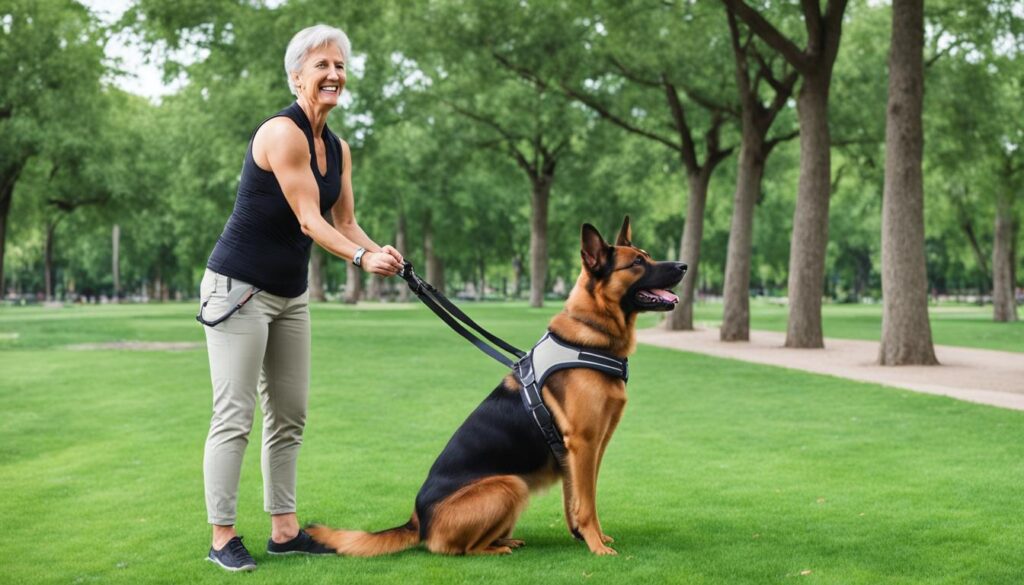

Training Your Dog with a No Pull Harness
Using a no pull harness for training your dog can be an effective way to teach leash manners and prevent pulling. By combining positive reinforcement and leash control techniques, you can guide your dog towards loose leash walking and create a more enjoyable walking experience for both of you.
“A no pull harness provides a gentle way to redirect a dog's attention and discourage pulling.”
When the dog pulls forward, the control loop on the harness will tighten around their chest, bringing their attention back to you. This redirection can help break the habit of pulling and encourage them to walk calmly at your side. As soon as your dog exhibits calm behavior or walks politely beside you, be sure to offer praise and reward them with treats or affection.
Consistency is key in the training process. Practice using the no pull harness and positive reinforcement techniques during every walk, reinforcing the desired behavior and discouraging pulling consistently. Remember to be patient and understanding, as it may take time for your dog to adjust to the new training methods.
If you're facing specific behavioral challenges or need additional guidance in leash training, it's always beneficial to consult with a local dog trainer. They can provide expert advice tailored to your dog's needs and help address any unique concerns you may have.
Benefits of Training with a No Pull Harness
A no pull harness offers several advantages when it comes to training your dog to walk on a leash:
- Preventing Pulling: The design of the harness helps discourage pulling by redirecting your dog's attention and providing a gentle reminder to stay by your side.
- Positive Reinforcement: By rewarding your dog for calm behavior and loose leash walking, you'll reinforce the desired habits and strengthen the bond between you.
- Enhanced Leash Control: The harness gives you better control over your dog's movements, offering a safer and more manageable walking experience.
- Loose Leash Walking: With consistent training, your dog can learn to walk on a loose leash, allowing for a more relaxed and enjoyable walk for both of you.
Remember, using a no pull harness is just one part of the training process. In addition to the harness, it's important to maintain a patient and positive attitude and to provide consistent training and reinforcement. With time and dedication, you can help your dog become a well-behaved and attentive walking companion.
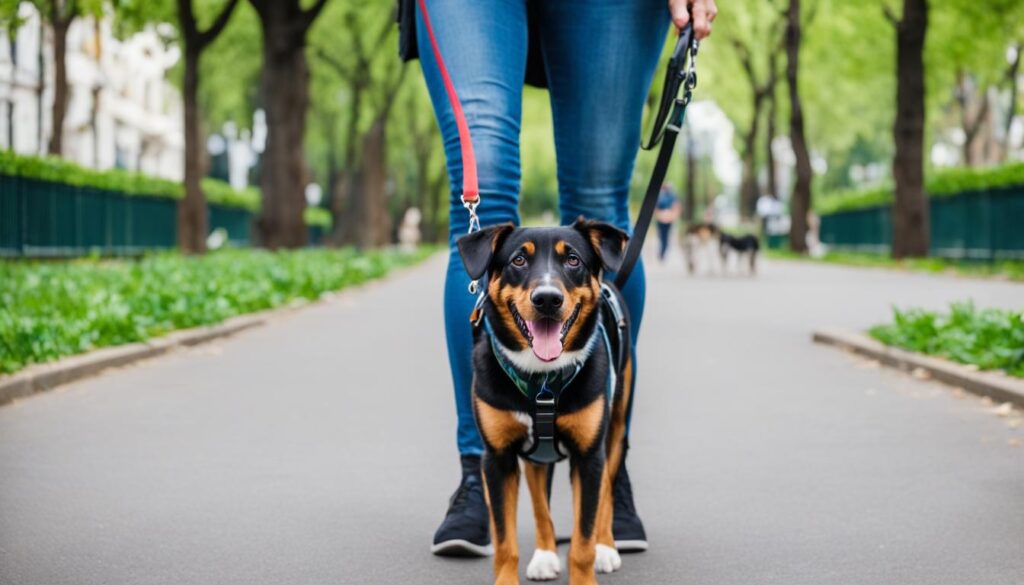

Benefits of Using a No Pull Dog Harness
Using a no pull dog harness offers numerous benefits for both owners and dogs. This type of harness is designed to prevent pulling during walks, making the experience more enjoyable and safer for everyone involved. Below are some key advantages of using a no pull dog harness:
- Preventing pulling: One of the primary benefits of a no pull dog harness is its ability to discourage pulling behavior. By attaching the leash to the front control loop of the harness, any forward pulling by the dog will be redirected, promoting better walking etiquette.
- Enhanced control: A no pull dog harness distributes force more evenly across the dog's body, providing owners with greater control during walks. This helps prevent strain on the dog's neck and back, reducing the risk of injury.
- Safety: Sudden pulling or jerking movements can lead to injuries in both dogs and owners. A no pull dog harness helps prevent these injuries by minimizing the impact of pulling and providing a more secure connection between the dog and the leash.
- Better communication: Using a no pull dog harness promotes better communication between the owner and the dog. The harness allows for clearer signals and cues, facilitating training and establishing a stronger bond of trust between the two.
To illustrate the benefits of using a no pull dog harness, consider the following scenario:
“When I started using a no pull dog harness with my Labrador Retriever, I immediately noticed a difference in our walks. The harness prevented her from pulling excessively and allowed us to walk more calmly and smoothly. Not only did it make the experience more enjoyable for both of us, but it also improved her leash manners. I felt more in control, and she seemed calmer and more focused on the walk. It's been a game-changer for us!” – Emily, dog owner
By utilizing a no pull dog harness, owners can effectively prevent pulling, enhance control, ensure safety, and strengthen their communication with their furry companions. This versatile tool is an invaluable asset for any dog owner looking to enjoy stress-free walks while promoting positive behavior.
Comparison of Benefits
| Benefits | No Pull Dog Harness | Traditional Harness |
|---|---|---|
| Prevents Pulling | ✅ | ❌ |
| Enhanced Control | ✅ | ❌ |
| Safety | ✅ | ❌ |
| Better Communication | ✅ | ❌ |
As seen in the table above, a no pull dog harness outperforms traditional harnesses in all key areas, making it a superior choice for preventing pulling, improving control, ensuring safety, and fostering better communication with your dog.
Teaching Your Dog to Walk on a Leash with a No Pull Harness
A no pull harness can be a valuable tool in teaching your dog to walk on a leash without pulling. With the right approach, consistency, and positive reinforcement, you can help your furry friend develop proper leash manners and enjoy peaceful walks together. Here's a step-by-step guide to teaching your dog to walk on a leash using a no pull harness.
- Introduce the harness: Start by letting your dog sniff and inspect the harness. This will help them become familiar with it and feel more comfortable.
- Gradually put on the harness: Put the harness on your dog gradually, ensuring a snug fit. Make any necessary adjustments to ensure it sits securely on their body.
- Attach the leash: Connect the leash to the front attachment point of the harness. This allows for better control and discourages pulling behavior.
- Start walking at a steady pace: Begin walking with your dog, keeping a consistent and steady pace. This will help establish a rhythm and encourage your dog to focus on walking beside you.
During the training process, it's crucial to use positive reinforcement to reward your dog's calm behavior and discourage pulling. You can offer treats, praise, or a combination of both when your dog walks calmly beside you without pulling on the leash. Be patient and consistent in your training efforts, as it may take time for your dog to fully grasp the concept of walking on a leash without pulling.
Remember that every dog is unique, and their progress may vary. It's essential to tailor your training approach to your dog's individual needs and personality. Consulting with a professional dog trainer can provide valuable guidance and support throughout the leash training process.
By using a no pull harness and implementing positive reinforcement techniques, you can teach your dog to walk on a leash without the struggle of constant pulling. Enjoy the journey of leash training, and soon you and your canine companion will be enjoying peaceful walks together.
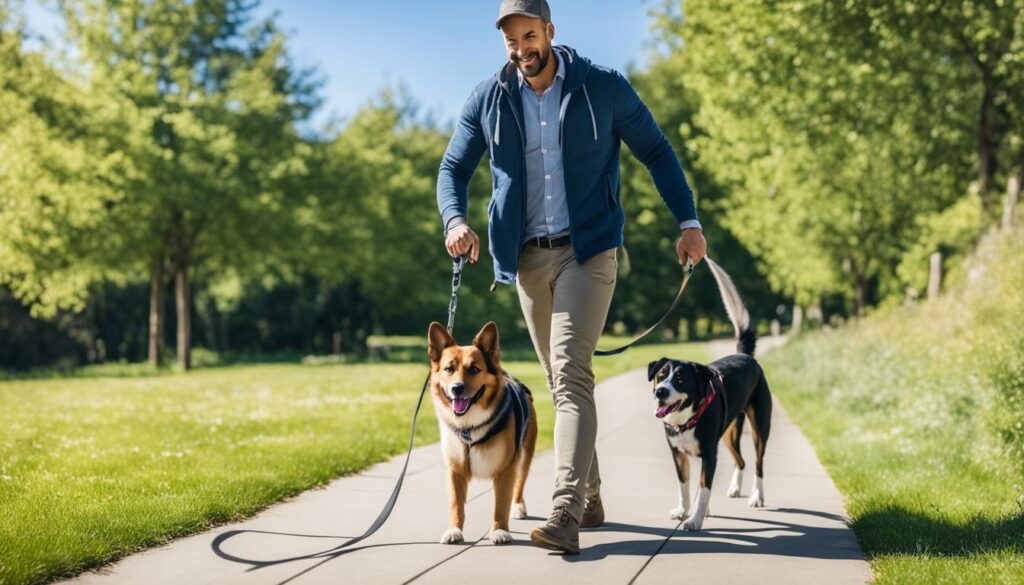

No Pull Harness for Strong Dogs
Strong dogs can often tend to pull on walks, making a no pull harness an essential tool. The harness's design, with a front attachment point, helps redirect the dog's forward momentum and discourages pulling.
The no pull harness for strong dogs is made of strong and durable materials that can withstand the pulling force of powerful breeds. Its secure construction provides better control, allowing you to walk your dog with confidence.
Using a no pull harness not only prevents injuries that can occur from excessive pulling or jerking movements but also makes the walking experience safer and more enjoyable for both you and your furry friend.
With the no pull harness, you'll have improved control over your strong dog, making your walks more pleasant and relaxed. Say goodbye to the struggle of pulling and hello to enjoyable outings with your faithful companion.
Steps to Properly Fit a No Pull Dog Harness
Properly fitting a no pull dog harness is essential for your dog's comfort and safety. Follow these easy steps to ensure a secure and effective fit:
- Step 1: Unbuckle the harness and slip it over your dog's head.
- Step 2: Adjust the straps so that they snugly fit your dog's body.
- Step 3: Make sure you can fit two fingers between the straps and your dog's skin for a comfortable fit.
- Step 4: Consult the manufacturer's sizing guidelines and measure your dog's chest girth to ensure the best fit.
- Step 5: Double-check that the harness is not too tight or too loose, restricting your dog's movement.
Remember, a properly fitted no pull dog harness will provide better control and prevent discomfort for your furry friend during walks.
“A properly fitted no pull dog harness ensures your dog's comfort and safety during walks.”
Here's an illustrative table summarizing the steps to properly fit a no pull dog harness:
| Steps | Description |
|---|---|
| Step 1 | Unbuckle the harness and slip it over your dog's head. |
| Step 2 | Adjust the straps to snugly fit your dog's body. |
| Step 3 | Ensure two fingers can fit between the straps and your dog's skin. |
| Step 4 | Consult the manufacturer's sizing guidelines and measure your dog's chest girth. |
| Step 5 | Check that the harness is not too tight or too loose, restricting your dog's movement. |
Properly fitting your dog with a no pull harness will ensure their comfort, safety, and a more enjoyable walking experience for both of you.
Preventing Pulling on Walks with a No Pull Harness
One of the main purposes of a no pull dog harness is to prevent pulling on walks. The harness's design, with a front attachment point, helps redirect the dog's forward momentum and discourages pulling behavior.
By attaching the leash to the front attachment point, any pulling forward will cause the harness to tighten around the dog's chest, bringing their attention back to the owner. This technique provides a gentle and effective way to discourage pulling and maintain control during walks.
Pairing this technique with positive reinforcement and leash control techniques can further enhance the effectiveness of a no pull harness. Using positive reinforcement, such as treats or praise, to reward calm behavior and loose leash walking can reinforce good habits and discourage pulling.
Leash control techniques, such as maintaining a relaxed grip on the leash and walking at a steady pace, can also contribute to preventing pulling on walks. Consistency in implementing these techniques and remaining patient throughout the training process is key to achieving success with a no pull harness.
With the implementation of a no pull dog harness and the combination of positive reinforcement and leash control techniques, you can enjoy pleasantly and stress-free walks with your dog while preventing pulling and maintaining control.
Eliminate the struggle of pulling on walks by incorporating a no pull harness into your dog's training routine.
No Pull Harness Techniques for Leash Training
Leash training your dog with a no pull harness requires specific techniques to discourage pulling and promote controlled walking. When your dog pulls forward, the control loop of the harness tightens around their chest, redirecting their attention and discouraging pulling behavior. To ensure effective leash training, it's important for you, as the owner, to maintain a relaxed grip on the leash and start walking at a steady pace.
As you walk, encourage your dog to stay by your side by using positive reinforcement techniques. When your dog walks calmly beside you without pulling, be sure to use praise and rewards as a form of reinforcement. This will help your dog associate walking beside you with positive experiences, reinforcing the behavior you want to encourage.
Consistency is key when using no pull harness techniques for leash training. Make sure to use these techniques every time you take your dog for a walk. With consistent practice, your dog will learn proper leash manners and walking behavior, making your walks more enjoyable for both of you.
Tips for Effective Leash Training with a No Pull Harness:
- Start training with short walks in low-distraction environments before gradually increasing the length and difficulty of your walks.
- Use calm and assertive energy during walks to help establish yourself as the leader.
- Redirect your dog's attention and encourage them to focus on you by using treats or toys as rewards.
- Practice loose leash walking by allowing a slight slack in the leash, keeping it relaxed while maintaining control.
- Be patient with your dog's progress and avoid punishing or scolding them for pulling. Positive reinforcement is more effective for training.
“A well-trained dog on a leash is a joyful companion during walks.”
Remember, leash training takes time and patience. Each dog is unique, and the training process may vary. As you work with your dog and utilize the no pull harness techniques, you'll see improvements in their leash behavior and enjoy more pleasant walks together.
| No Pull Harness Techniques | Description |
|---|---|
| Control Loop Tightening | The control loop of the no pull harness tightens around the dog's chest when they pull forward, redirecting their attention and discouraging pulling. |
| Relaxed Grip on the Leash | Maintain a relaxed grip on the leash to communicate a calm energy and prevent unintentional tension that may encourage pulling. |
| Steady Pace Walking | Start walking at a steady pace to signal to your dog that they should match your pace and keep a controlled walking style. |
| Positive Reinforcement | Reward your dog with praise, treats, or toys when they walk calmly beside you without pulling, reinforcing the desired behavior. |
| Consistent Practice | Use the no pull harness techniques consistently during every walk to establish proper leash manners and prevent pulling over time. |
Conclusion – How To Use No Pull Dog Harness
Using a no pull dog harness is an effective way to prevent pulling on walks and improve leash manners. By following the step-by-step process of fitting the harness properly and employing positive reinforcement techniques, you can train your dog to walk calmly beside you.
The design of the no pull dog harness, with its front attachment point, redirects your dog's forward momentum and discourages pulling behavior. This allows for a more enjoyable and safer walking experience for both you and your furry companion.
Remember, patience and consistency are key in your training efforts. Consult with a local trainer for specific behavioral concerns and expert guidance. With time and practice, your dog will learn to walk on a leash without the struggle of pulling, making your walks more enjoyable and stress-free.
FAQ – How To Use No Pull Dog Harness
How do I use a no pull dog harness?
To use a no pull dog harness, first, ensure it is fitted securely around your dog's chest using the adjustable straps. Attach the lead to the front control loop of the harness. When your dog pulls, the harness will tighten, redirecting their attention and discouraging pulling.
What are the benefits of using a no pull dog harness?
Using a no pull dog harness has several benefits. It prevents pulling on walks, distributes force evenly, reduces strain on the dog's neck and back, prevents injuries caused by sudden pulling, and promotes better communication and trust between the owner and the dog.
How do I choose the right no pull dog harness?
When choosing a no pull dog harness, be sure to select the right size and design for your dog's needs. Look for a harness with a front attachment point to discourage pulling. Measure your dog's chest girth and refer to the manufacturer's sizing guidelines for a proper fit.
What are the steps to properly fit a no pull dog harness?
To properly fit a no pull dog harness, start by slipping it over your dog's head and adjusting the straps to snugly fit their body. Ensure you can fit two fingers between the straps and your dog's skin. Follow the manufacturer's guidelines for sizing and adjust the harness around the chest and between the front legs.
How can I train my dog to walk on a leash with a no pull harness?
Training your dog to walk on a leash with a no pull harness involves a combination of positive reinforcement and leash control techniques. Use the control loop on the harness to redirect your dog's attention when they pull. Praise and reward your dog for walking calmly beside you.
Can a no pull harness be used for strong dogs?
Yes, a no pull harness can be used for strong dogs. The harness's design, combined with strong and durable materials, helps redirect a strong dog's forward momentum and discourages pulling. It provides better control and prevents injuries caused by excessive pulling.

